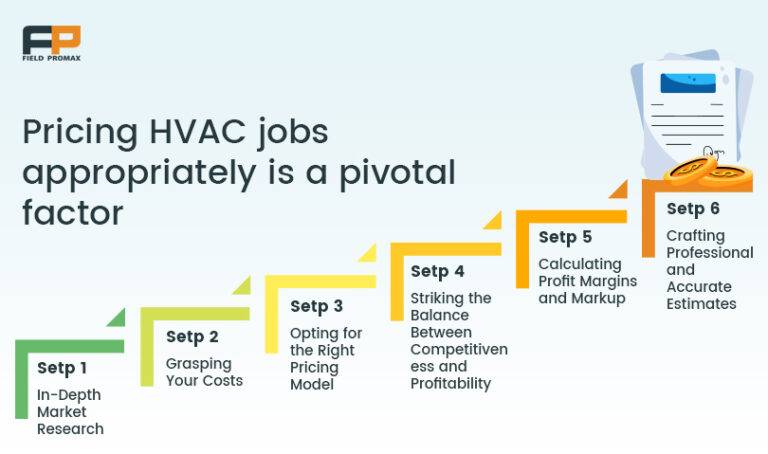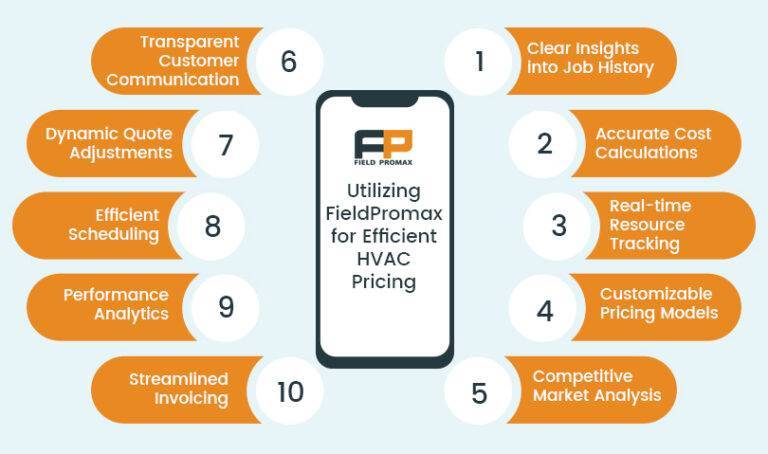Maximizing Profits with Field Promax: HVAC Job Pricing Strategies
Posted on 13 September, 2023 by Joy Gomez

In recent years, the HVAC sector has witnessed an impressive growth rate of 13%, signaling its expansion. Projections indicate that the global HVAC market will reach a substantial size of $367.5 billion by 2030.
However, as demand surges, competition intensifies, creating challenges for HVAC contractors striving to both survive and generate favorable earnings. Within this landscape, various enterprises within the industry are reducing their pricing for HVAC projects, aiming to attract customers and differentiate themselves. Yet, this approach often erodes their profit margins.
Avoiding this predicament is undoubtedly a priority, isn’t it? So, the question remains: How to price HVAC jobs effectively to strike a harmonious balance between profitability and satisfying customer expectations?
Well, worry not, this HVAC pricing guide for contractors will help you.
Why track the cost of each job?
In the HVAC (heating, ventilation, and air conditioning) world, how you set your prices is really important. It can determine whether your business does well or struggles. Pricing affects how much money you make, how happy your customers are, and how much your business can grow. So, it’s a big deal for any HVAC company.
The most important thing pricing does is make sure your business makes enough money to cover its costs and also make a profit. If you set your prices right, you can still have prices that customers like while also making enough money for your business. It’s like finding the sweet spot between getting customers and making money for your company.
Doing so requires regular monitoring and evaluation of pricing effectiveness.
But how to price an HVAC job. Let’s find out.
How to price HVAC jobs?
Pricing HVAC jobs appropriately is a pivotal factor that can significantly shape the trajectory of your HVAC business. To assist you in navigating this critical aspect of your operations, let’s delve deeper into key strategies and practical tips that can empower you to establish a pricing framework that drives success.

1. In-Depth Market Research:
Embarking on your pricing journey begins with a comprehensive exploration of your market landscape. This involves researching and understanding what your competitors are charging for similar HVAC services in your local area. By identifying the prevailing price range, you can position your offerings competitively.
For instance, if your research reveals that other HVAC companies charge around $100 for a standard maintenance service, you can utilize this insight to set your prices in a way that resonates with potential customers.
2. Grasping Your Costs:
Sustaining profitability within your HVAC business is intrinsically tied to your ability to grasp your costs with utmost clarity. This understanding forms the bedrock upon which you can build a pricing strategy that not only covers your expenditures but also secures a healthy margin of profit. Delving into your costs involves a comprehensive dissection, enabling you to categorize them into two essential components: direct costs and indirect costs.
2.1 Direct Costs: Materials and Labor
Direct costs are the tangible expenses directly linked to the provision of your HVAC services. These encompass the costs of materials and the compensation you provide to your workforce. Materials, ranging from piping and insulation to specific HVAC components, constitute the physical essentials that go into your projects. The costs associated with procuring these materials must be meticulously factored into your pricing equation.
Similarly, HVAC labor rates represent the wages paid to your technicians and workers who execute the hands-on tasks required for installations, repairs, and maintenance. This encompasses not only their basic pay but also any additional expenses tied to benefits, insurance, and other compensation-related factors. Understanding the HVAC labor rate ensures that your pricing covers the actual human effort expended on each project.
2.2 Indirect Costs: Overhead Expenditures
Beyond the direct costs, your pricing strategy must also accommodate indirect costs, often referred to as overhead expenditures. These encompass a spectrum of expenses that contribute to the smooth functioning of your business but are not directly attributable to individual projects. Overhead expenditures include aspects like:
- Rent and Facilities: The cost of the physical space you operate from, whether it’s an office, showroom, or storage facility.
- Utilities: Expenses related to electricity, water, heating, and cooling required to keep your workspace operational.
- Administrative Overheads: Costs tied to administrative functions such as salaries of office staff, accounting, legal services, and software subscriptions.
- Marketing and Advertising: The funds allocated to promoting your HVAC services and maintaining your brand presence.
- Insurance: Premiums paid to protect your business, employees, and projects from potential risks and liabilities.
- Equipment Maintenance: Costs related to servicing and maintaining the tools and equipment used in HVAC operations.
3. Opting for the Right Pricing Model:
The choice between hourly rates and flat fees can significantly influence how your customers perceive your pricing structure. Hourly rates offer transparency in billing, while flat fees provide a more upfront understanding of total costs. Tailoring your approach to your target market’s preferences is vital.
For instance, if you charge $50 per hour for HVAC repairs, customers can easily estimate costs based on the time taken for the service.
4. Striking the Balance Between Competitiveness and Profitability:
Striking a balance between competitiveness and profitability is pivotal. While it’s essential to remain competitive within your market, your pricing should also reflect the value you bring to your customers. Consider highlighting unique selling points, such as exceptional service quality or expedited response times, to justify slightly higher prices.
For example, if the average rate for furnace installation in your region is $2000, but your business offers a same-day installation guarantee, you can position your service at $2200 to account for this added value.
5. Calculating Profit Margins and Markup:
Understanding the relationship between profit margins and markup is integral to effective pricing. Profit margins denote the percentage of profit gained from each service, while markup represents the amount added to costs to arrive at the final price.
As an illustration, if your expenses for a repair job amount to $300 and you aim for a 20% profit margin, your calculated price would be $375 ($300 + 20% of $300).
6. Crafting Professional and Accurate Estimates:
Transparency and professionalism are pivotal when presenting pricing information to potential customers. Crafting detailed and precise estimates that outline all components of the service cost is essential for building trust. A comprehensive estimate should encompass all expenses, from materials to labor.
For instance, when providing an estimate for a new HVAC system installation, ensure that you itemize the cost of the unit, installation labor charges, and any supplementary fees.
Utilizing FieldPromax for Efficient HVAC Pricing
FieldPromax – a field service management software can be a game-changer when it comes to determining the right pricing for your HVAC jobs. Let’s explore how this technology can empower your business with better decision-making and enhanced efficiency in pricing strategies.

- Clear Insights into Job History:
FieldPromax software maintains a record of past HVAC jobs, allowing you to analyze historical data. This helps in understanding the time, materials, and efforts required for similar tasks, aiding in accurate pricing decisions. - Accurate Cost Calculations:
By integrating material costs, labor expenses, and other overheads, FieldPromax software provides a comprehensive view of your actual costs. This ensures your pricing covers all expenditures, promoting profitability. - Real-time Resource Tracking:
Field Promax tools help monitor the availability and location of your field technicians and equipment in real time. This enables you to allocate resources efficiently, minimizing idle time and optimizing pricing based on actual usage. - Customizable Pricing Models:
With FieldPromax software, you can set up customizable pricing models based on factors like service type, complexity, and location. This allows for tailored pricing that accurately reflects the value of your services. - Competitive Market Analysis:
Many FieldPromax systems offer integration with market data, enabling you to compare your pricing with industry standards and local competitors. This ensures your rates remain competitive while maintaining profitability. - Transparent Customer Communication:
FieldPromax software allows you to provide clients with detailed, itemized estimates directly through the platform. This transparency builds trust and helps clients understand the breakdown of costs. - Dynamic Quote Adjustments:
In situations where job requirements change, FieldPromax software lets you quickly adjust quotes by updating labor hours, material quantities, or other variables. This flexibility ensures accurate pricing even in evolving scenarios. - Efficient Scheduling and Route Optimization:
Optimized scheduling through FieldPromax software reduces travel time and enhances technician productivity. This, in turn, affects pricing as fewer hours are spent on commuting. - Performance Analytics:
FieldPromax software provides insights into the performance of your HVAC technicians, helping you identify efficiency levels. This data can guide your pricing strategy based on the skill and speed of your workforce. - Streamlined Invoicing:
With integrated invoicing features, FieldPromax software ensures that the pricing discussed with clients is seamlessly translated into invoices, minimizing discrepancies.
Wrapping up
Setting the right prices for HVAC projects is about finding a good balance between knowing how much materials cost, understanding labor expenses, and considering other important factors. Doing well in the HVAC market means creating a plan for how much to charge and letting customers know about your fair prices.
Even though this process might take a bit of time, you can make it easier by using special tools like Field Promax. This tool helps you work better and make more money by quickly figuring out how much a project will cost.
Originally Published at:- FIELD PROMAX ( HVAC Job Pricing )
http://www.ayushremedies.com
12 April, 2017